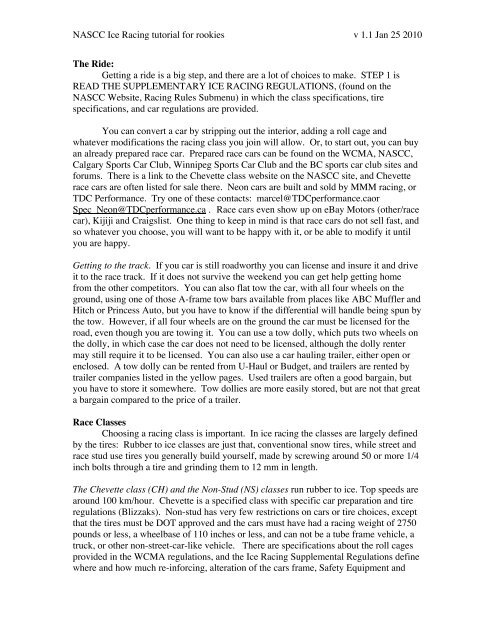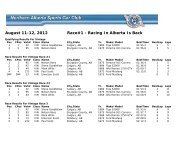Ice Racing 101 - nascc
Ice Racing 101 - nascc
Ice Racing 101 - nascc
Create successful ePaper yourself
Turn your PDF publications into a flip-book with our unique Google optimized e-Paper software.
NASCC <strong>Ice</strong> <strong>Racing</strong> tutorial for rookies v 1.1 Jan 25 2010<br />
The Ride:<br />
Getting a ride is a big step, and there are a lot of choices to make. STEP 1 is<br />
READ THE SUPPLEMENTARY ICE RACING REGULATIONS, (found on the<br />
NASCC Website, <strong>Racing</strong> Rules Submenu) in which the class specifications, tire<br />
specifications, and car regulations are provided.<br />
You can convert a car by stripping out the interior, adding a roll cage and<br />
whatever modifications the racing class you join will allow. Or, to start out, you can buy<br />
an already prepared race car. Prepared race cars can be found on the WCMA, NASCC,<br />
Calgary Sports Car Club, Winnipeg Sports Car Club and the BC sports car club sites and<br />
forums. There is a link to the Chevette class website on the NASCC site, and Chevette<br />
race cars are often listed for sale there. Neon cars are built and sold by MMM racing, or<br />
TDC Performance. Try one of these contacts: marcel@TDCperformance.caor<br />
Spec_Neon@TDCperformance.ca . Race cars even show up on eBay Motors (other/race<br />
car), Kijiji and Craigslist. One thing to keep in mind is that race cars do not sell fast, and<br />
so whatever you choose, you will want to be happy with it, or be able to modify it until<br />
you are happy.<br />
Getting to the track. If you car is still roadworthy you can license and insure it and drive<br />
it to the race track. If it does not survive the weekend you can get help getting home<br />
from the other competitors. You can also flat tow the car, with all four wheels on the<br />
ground, using one of those A-frame tow bars available from places like ABC Muffler and<br />
Hitch or Princess Auto, but you have to know if the differential will handle being spun by<br />
the tow. However, if all four wheels are on the ground the car must be licensed for the<br />
road, even though you are towing it. You can use a tow dolly, which puts two wheels on<br />
the dolly, in which case the car does not need to be licensed, although the dolly renter<br />
may still require it to be licensed. You can also use a car hauling trailer, either open or<br />
enclosed. A tow dolly can be rented from U-Haul or Budget, and trailers are rented by<br />
trailer companies listed in the yellow pages. Used trailers are often a good bargain, but<br />
you have to store it somewhere. Tow dollies are more easily stored, but are not that great<br />
a bargain compared to the price of a trailer.<br />
Race Classes<br />
Choosing a racing class is important. In ice racing the classes are largely defined<br />
by the tires: Rubber to ice classes are just that, conventional snow tires, while street and<br />
race stud use tires you generally build yourself, made by screwing around 50 or more 1/4<br />
inch bolts through a tire and grinding them to 12 mm in length.<br />
The Chevette class (CH) and the Non-Stud (NS) classes run rubber to ice. Top speeds are<br />
around 100 km/hour. Chevette is a specified class with specific car preparation and tire<br />
regulations (Blizzaks). Non-stud has very few restrictions on cars or tire choices, except<br />
that the tires must be DOT approved and the cars must have had a racing weight of 2750<br />
pounds or less, a wheelbase of 110 inches or less, and can not be a tube frame vehicle, a<br />
truck, or other non-street-car-like vehicle. There are specifications about the roll cages<br />
provided in the WCMA regulations, and the <strong>Ice</strong> <strong>Racing</strong> Supplemental Regulations define<br />
where and how much re-inforcing, alteration of the cars frame, Safety Equipment and



